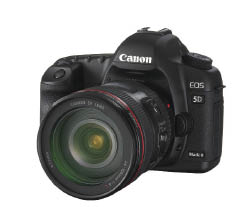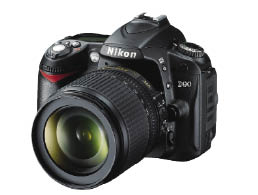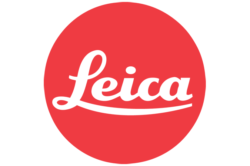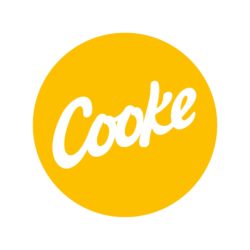From Introduction to Issue 19+20 November+December 2008 Film and Digital Times
Divination was not Harry Potter’s strong point. Lately, it has eluded most economists, politicians and pundits as well. To guess where motion pictures are moving, take a look at three digital still cameras introduced within the past few weeks.
In 2008, we saw an avalanche of activity in anamorphic and 3D production, a maturing of 2K digital for television drama and series, continued use of 35mm film for big budget Hollywood features, HD for news and documentaries, every conceivable format for commercials, RED rising, and impatience for 4K to become practical, insurable and prevalent.
There is one sure-bet business to be in. To paraphrase Mr. McGuire advising the Dustin Hoffman character in The Graduate, “Ben, I just want to say one word to you, just one word…”
“Yes, sir…” says Ben.
“Data Recovery.”
The difference between one word or two matters little in a place where Sam Goldwyn once said, “In two words…impossible.” However, with hard drives all but guaranteed to fail 90% of the time, and flash memory as volatile as prematurely unzipped-in-daylight changing bags—“oops, I just reformatted the entire day’s work”—data recovery is more predictable than economic recovery. Data recovery companies are standing by to surgically restore your precious bytes at great expense. We recently parted, gladly too, with $2500 for the recovery of a 250 GB drive that had choked as the camera irrevocably dumped its data thereto.
By all accounts, this was the best Cinec yet. But, whispers of 4K uncompressed cameras by ARRI, Aaton, Sony, Panavision and others were not breathless. So, on my highly unscientific hyperventilation scale of immediacy, I’m guessing that we will see practical 4K uncompressed camera protoypes and untouchables-under-plexi at NAB 2009, deliveries by NAB 2010, and serious embrace by NAB 2011. The biggest challenge is not the chip.
“The biggest challenge is workflow, which I know is your least favorite word,” said one of my most prescient gurus, Volker Bahnemann, President of ARRI Inc in New York.
Franz Kraus, Managing Director of ARRI in Munich, is another respected oracle of all things visual, analog and digital. “It’s more about storage, moving data, and post,” he said.
Michael Phillips, wizard of Avid, said, “Higher resolution post production will rely on the accuracy of the metadata, since there will always be an offline/online mastering process. For this type of editing, a proxy will be created to allow the real time performance needed to keep the creative flow at the highest level.” In other words, sooner.
The other brilliant Michael, Michael Bravin, Mahatma of Band Pro, said, “I’d be surprised if anyone showed a working, fully developed 4K next-gen camera at NAB 2009, and I know a lot of work is being done on them. You need at least a 36 Megapixel sensor, no Bayering: that’s 12 Megapixels per color—4 for high, 4 for midrange and 4 for shadow exposure.”
Denny Clairmont, ever clairvoyant, thinks it will be sooner. So does another FDTimes Soothsayer, Otto Nemenz. Amnon Band’s prophesy is similar to mine.
The “two products that weren’t there” had a palpable offstage presence, similar to Harry Potter’s nemesis “He Who Must Not Be Named.” While Canon 5D Mark II and Nikon D90 cameras were being unpacked in Cologne for Photokina, these two HD movie-capable digital SLR cameras upstaged a lot of chatter at Cinec. Then, the Panasonic Lumix DMC-G1 was announced just hours before we went to press. It points the way to high-resolution digital finders and reduction of flange focal depth by removing the mirror (G1 depth is 20mm). Shorter flange depth means lenses can be made with fewer elements and higher resolution. Compare, for example, Leica and ZEISS rangefinder lenses to their SLR series.
The Nikon D90 and Canon 5D Mk II shoot compressed HD. RED set out to build a motion picture camera using the digital SLR as its paradigm. Now the digital SLR is in parallel evolution.
One of the speed bumps to the 4K speedway what Dr. Hans Kiening has been telling us all year: we need a 5K , 6K or ideally 10K sensor to get acceptable downsampled images in 4K. (Read his report at www.arri.de/entry/4kplus-systems.htm)
The other challenge is storage while shooting and the dreaded word: workflow. How are you going to pump all that data into your onboard magazine? And, how will you secure your 4K feature’s 60 Terabytes of data, and avoid the odyssey to Drivesavers in Novato, California? Moore’s 18 month law puts practical and affordable 4K Raw uncompressed data storage somewhere 18 months to 3 years from now.
I hasten to disclaim, as they do at banks and brokerages, that past performance is no guarantee of future salubrity, and you should not squander your production’s budget on the auguries of a few brilliant men—but it would be wise to listen to them.
For at least the next year, ARRI appears solidly in the 2K and HD world with its D-21 camera. I was surprised not to see any 2K digital magazines for the world’s vast supply of Arriflex 16SR-1, 2 and 3 cameras. D-16? Band Pro and Sony are getting their first F35 1920×1080 PL mount cameras onto productions this month. Jean-Pierre Beauviala and Aaton are up to something: they announced a 2K / 4K film recorder using the venerable Aaton movement, so I suspect (wild guess) that a 4K digital magazine for Penelope might be in the works.
Anamorphic jobs are now shot with different film apertures (3 perf or 4 perf) and different sensor sizes (4:3 or 16:9). Hawk has an arsenal of available anamorphics that do a clever thing: you can set them up for 2x squeezed or 1.3x “gently squeezed.”
ARRI demonstrated m-scope, a practical way to shooting in anamorphic with a D-21 / D-21 HD. The D-21 sensor captures a 4:3 downsampled, squeezed 1920 x 1440 HD image. That image is split into two HD-SDI streams, one containing the even, the other containing the odd lines. Each stream is now 1920 x 720 pixels, and because each stream contains half the lines, the image is effectively unsqueezed for viewing on set. The Sony SRW-1 deck is capable of recording dual streams, and both streams are stored on one tape. For editing, only one stream is used. Quantel iQ supports this: the two streams are recombined in post, resulting in the original 1920 x 1440 HD image.
P+S Technik announced an emphasis on 2K production. Weisscam and Silicon Imaging 2K cameras are being delivered. The P+S Technik IMS lens mount system (above) could become an open industry standard, because it lets you mount almost any lens on any IMS-equipped camera. Alfred also told us that P+S Technik will discontinue 16mm service and 16SR upgrades in order to devote more resources to the 2K effort.
It felt as though someone at Cinec had flipped a switch and turned off Super 16mm production everywhere except ARRI, where a large part of the exhibition’s real estate was devoted to Super 16 footage de-grained by Digital Film Central of Vancouver. I heard some skeptics mutter, inaccurately, that degrained Super 16 would look like HD. But I don’t believe that film relies on grain to achieve its look any more than flicker should be considered essential to the film look. Film look, for me, is shallow depth of field, wide and smooth exposure latitude, with a “rounded, full and smooth texture” to borrow some of Howard Preston’s oenophilisticisms.
What about compressed 4K like RED? I thought for sure that RED had shown Hollywood how we can live with visually or vicariously lossless compression.
Jim Jannard, I suspect, is looking beyond Hollywood. He writes, “RED Digital Cinema has chosen Las Vegas to build the new RED Ranch Headquarters. Located about ten minutes from McCarran International Airport and the Las Vegas Strip, RED Ranch facilities will support design, engineering, manufacturing, sales, service and operations… plus a soundstage, restaurant, town center and limited housing on an 80 acre site. Opening is scheduled for 2010… Everything in life changes… including our camera specs and delivery dates…”
In the past year, thousands of RED ONE cameras were shipped; they shot hundreds of features, hundreds of commercials and music videos all over the world. Ted Schilowitz says, “We are seeing post production houses from small boutiques to the largest studios putting in the right tools and doing their homework to insure they know the options for posting with RED, from TV all the way to theatrical 4K DCP and Film-Outs. There are a couple of very elegant and simple post paths using the Apple/RED integration using desktop hardware for offline editing with no rendering or processing of files. In addition, there are logical solutions for those shooting on RED and cutting on Avid (there are many projects doing this) and a real-time “virtual telecine” option using Assimilate’s Scratch that has become quite popular for Commericals and TV.”
I wouldn’t be surprised if the new RED Ranch Headquarters erects a sign like McDonalds’ with a continuous tally of millions sold, visible from every airplane making the final approach to future NAB shows in Las Vegas.











What is the noticeable difference between 2K and 4K when projected on a movie screen?